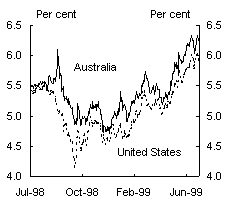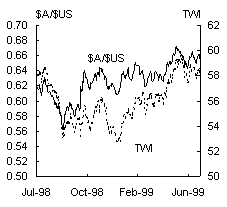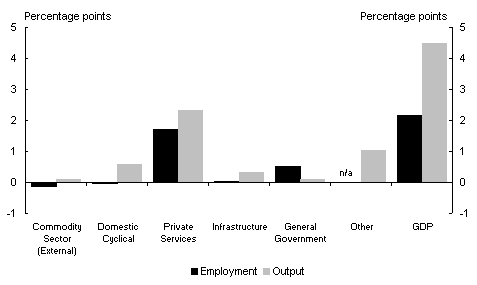Australias GDP growth in 1998-99 was 4.5 per cent, significantly stronger than both the May 1998 Budget growth forecast of 3 per cent and the December 1998 Mid-Year Economic and Fiscal Outlook (MYEFO) growth forecast of 3 per cent. Nevertheless, the composition of growth was broadly in line with the MYEFO forecasts, with a strong contribution from domestic demand offsetting weak net exports. Table 1 compares the 1998-99 outcomes with the May 1998 Budget and the MYEFO forecasts.
The higher GDP growth outcome compared with the MYEFO forecasts largely reflected a stronger contribution to growth by household consumption and a larger inventory accumulation (stocks), more than offsetting the higher net export detraction and a lower contribution from public final demand (Chart 2).
Chart 2: Contributions to GDP Growth 1998-99
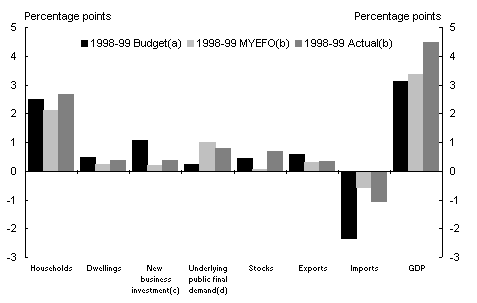
(a) 1998-99 Budget forecasts were based on constant price estimates.
(b) 1998-99 MYEFO and actuals were based on chain volume measures.
(c) New business investment represents headline business investment adjusted for second hand asset purchases.
(d) Underlying public final demand represents the sum of public consumption and public investment, after abstracting from the impact on the latter of second-hand asset sales to the private sector.
Table 1: 1998-99 Budget and MYEFO forecasts and outcomes
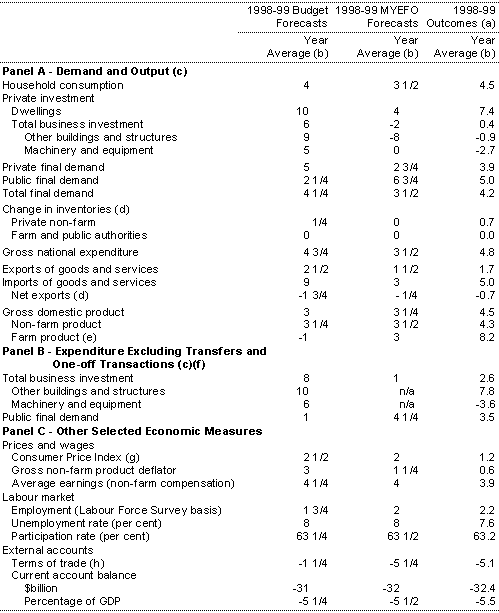
(a) Calculated using original data.
(b) All figures refer to the percentage change on preceding year unless otherwise indicated.
(c) The 1998-99 Budget forecasts were based on constant price measures using average 1989-90 prices. The MYEFO forecasts and the outcomes for 1998-99 were based on chain volume measures, with reference years of 1996-97 and 1997-98 respectively.
(d) Percentage point contribution to GDP growth.
(e) 1998-99 outcome calculated at basic prices.
(f) Transfers are net of second hand asset sales from the public sector to the private sector. One-off transactions are lumpy imports of aircraft, ships and satellites.
(g) The Budget forecast was based on the 12th CPI series while the MYEFO forecast and the 1998-99 outcome were both based on the 13th series.
(h) The Budget forecast was adjusted to exclude computer import prices, while the MYEFO forecast and the 1998-99 outcome were both unadjusted, as they were based on chain volume measures which are less distorted by movements in computer prices.
THE DOMESTIC ECONOMY
As in 1997-98, the major contributor to strong GDP growth in 1998-99 was household consumption expenditure. With some moderation in household consumption growth expected over the course of 1998-99, the outcome was stronger than anticipated.
The May 1998 Budget (Statement 2) identified a number of factors that could impact on the Australian economy (in either a positive or negative direction relative to the forecasts) over 1998-99. These included uncertainty surrounding the rate of world economic growth; the size of the stimulus to domestic demand flowing from declines in interest rates over 1997-98; and the consumption behaviour of AMP shareholders following the societys demutualisation and listing on the Australian Stock Exchange in June 1998.
In addition, there were a number of other favourable factors that also supported private demand throughout 1998-99: inflation continued to surprise on the downside, with intense price competition (motor vehicles were a prime example) and robust productivity growth both acting to subdue overall consumer price rises. Rising private sector wealth, relatively strong real wage growth, sustained employment growth and lower unemployment outcomes, and improved consumer confidence, all contributed towards creating an environment conducive to strong consumption growth being sustained in 1998-99.
The success in re-directing Australian exports to more strongly growing regions continued in 1998-99. The depreciation in the Australian dollar over the latter half of 1998 assisted to counterbalance the negative external impact arising from the Asian financial crisis. This assisted in increasing the competitiveness of Australian exports and domestic import-competing industries. In concert, these factors resulted in net exports detracting less from domestic growth than originally forecast at budget time.
In 1998-99, fiscal policy continued to build the level of national savings through the Governments ongoing programme of fiscal consolidation. The rise in the underlying general government cash surplus (from $1.3 billion in 1997-98 to $4.2 billion in 1998-99), ensured that the Government did not contribute directly to the increase in the current account deficit (CAD). Further, when combined with receipts derived from assets sales, the headline fiscal position provided for a reduction in Commonwealth general government net debt (from 14.7 per cent of GDP in 1997-98 to an estimated 12.1 per cent of GDP in 1998-99).
The Reserve Bank reduced official interest rates (by 25 basis points) to 4.75 per cent on 2 December 1998. Long-term (10-year) bond yields and the exchange rates fell over the first half of 1998-99. Significant falls in long-term bond yields throughout the latter half of 1998 were driven by weaker global economic growth and inflation expectations, flight to quality buying of US Treasury securities and reductions in official interest rates amongst central banks.
In contrast to the latter half of 1998, upward revisions to global economic growth and inflation expectations prompted a gradual rise in long-term bond yields in the first half of 1999. Rising long-term bond yields occurred alongside a rebound in the $A/$US and the TWI, and by the end of 1998-99, the rise in both bond yields and the exchange rate had more than unwound the falls observed over the latter half of 1998. Nevertheless, the exchange rate and Australian long-term bond yields over 1998-99 remained well below the average levels recorded over 1997-98.
As shown in Chart 3, during a period of heightened global financial market instability and investor uncertainty, international investors confidence in Australia allowed the spread between Australian and US long-term bond yields to remain low (30 basis points over 1998-99).
|
Chart 3: 10 year bond yields Australia and the United States(a) |
Chart 4: $A/$US and TWI |
|
|
|
|
(a) Monthly averages of daily rates Source: Datastream |
|
Supply-side developments In 1998-99, industries in the Australian economy that benefited from the strength of the household sector contributed solidly to GDP and employment growth. By industry grouping, Chart 5 shows that private service industries contributed 2.3 percentage points to GDP growth in 1998-99, with solid outcomes for property and business services, finance and insurance, and wholesale trade. Domestic cyclical industries contributed 0.6 percentage points to growth, with a pick-up in manufacturing (as the effects of the Asian crisis unwound) helping to offset the moderation in the contribution by the construction sector (following very strong growth in the previous year). Contributions to output growth in the infrastructure sector continued to be supported by communication services, while output in commodity (external) and general government industries were broadly flat. Total employment grew 2.2 per cent in 1998-99; this represented a significant strengthening in growth over the previous year. Employment growth was concentrated amongst private service industries. Favourable trading conditions in retail trade and property and business services resulted in private service industries contributing 1.7 percentage points to total employment growth. Growth in general government employment, which contributed 0.5 percentage points to total employment growth in 1998-99, followed two years of flat government employment growth. With industry gross value added growing at around twice the pace of employment growth in 1998-99, implied labour productivity growth remained robust at 2.3 per cent in 1998-99. This was slightly lower than the high productivity growth of 3.4 per cent recorded in 1997-98. |
|
Very high productivity growth continued to be achieved by infrastructure industries (up 4.5 per cent), with the communication sector the key to ongoing productivity growth in this industry. Productivity growth in commodity industries rose sharply (up 3.6 per cent in 1998-99 from 1.8 per cent in 1997-98), with increased productivity in agriculture, forestry and fishing more than offsetting falling productivity in the mining industry. Productivity growth amongst domestic cyclical industries was also strong, rising by 3.3 per cent in 1998-99, with solid productivity growth in manufacturing more than offsetting the productivity decline in construction (which followed two years of high productivity growth). Robust productivity growth of 2.7 per cent amongst private service industries was strongest for wholesale trade, business and hospitality related services. In contrast, general government productivity contracted by 1.8 per cent in 1998-99 (following two years of above average productivity growth), as a result of both lower recorded output and higher employment. Chart 5: Industry contribution to GDP and employment growth, 1998-99(a)
(a) Output refers to gross value added at basic prices. (b) Other captures the contribution to GDP associated with the ownership of dwellings, taxes less subsidies, and the statistical discrepancy. Source: ABS Catalogue No. 5206.0, 6202.0 and 6203.0. |
Domestic Demand
Total final (domestic) demand in 1998-99 rose by 4.2 per cent. Despite the increasing contribution of exports to the overall economy (exports of goods and services accounted for around 20 per cent of total GDP in 1998-99), the Australian economy still predominately produces for the domestic market.
In 1998-99, the production of non-tradeables in Australia accounted for around three-quarters of the economy and around 82 per cent of total employment. The production of non-tradeables was the main contributor to GDP growth over the year, contributing around 3.6 percentage points to industry gross value added (measured at basic prices) of 4.0 per cent in 1998-99.
Private consumption grew by 4 per cent in 1998-99: this was percentage point higher than the May 1998 Budget forecast and 1 percentage point higher than the MYEFO forecasts. Higher consumption growth reflected stronger than expected growth across all components of private consumption, with the services and motor vehicles components (record sales of motor vehicles were recorded in 1998) both particularly strong. Growth in retail trade was also solid in 1998-99.
The strength in private consumption continued to be supported by low inflation, low interest rates, robust employment growth and falling unemployment, relatively strong real wage growth, high household borrowing and rising private sector wealth. The growth in private sector wealth in 1998-99 was driven by strong rises in both equity and house prices, which grew by around 5 and 8 per cent respectively. Given the increase in direct share ownership by households, the rise in equity prices is likely to have flowed through to consumption expenditure more directly than has historically been the case.
The one-off windfall gain to AMP policy holders associated with the AMP demutualisation and, further gains in the share price of the partially privatised Telstra, clearly gave private consumption a considerable boost. The demutualisation of the AMP Society effectively unlocked around $20 billion (market capitalisation) of wealth available to AMP shareholders, with roughly 80 per cent of this wealth going to domestic shareholders. When combined with stronger employment growth and the rebound in consumer confidence, rising private sector wealth clearly resulted in a stronger impact on consumption than was factored in at the time of the May 1998 Budget.
The favourable conditions that underpinned stronger growth in private consumption were, in part, reflected in the large increase in consumer sentiment over 1998-99, with the Westpac-Melbourne Institute consumer sentiment survey rising by 18 per cent in through-the-year terms. This came after the weakening in sentiment over the middle and latter parts of 1997-98, which coincided with the downturn in troubled Asian economies.
Dwelling investment grew by 7.4 per cent in 1998-99 to reach its highest level on record. The May 1998 Budget forecast dwelling investment to grow by 10 per cent in 1998-99, which was revised down to 4 per cent in the MYEFO. This downward revision reflected weaker partial indicators of dwelling investment in the September quarter 1998 and pessimism surrounding the Asian financial crisis. A rapid recovery in consumer and business confidence coupled with low interest rates, contributed to dwelling investment being stronger than forecast in the MYEFO, despite declining housing affordability over 1998-99 (albeit from high levels) as a result of rising house prices.
Following six years of strong expansion, underlying business investment grew by 2.6 per cent in 1998-99. This moderation was broadly in line with the MYEFO forecast of 1 per cent growth but below the 8 per cent rise forecast at budget time. The slowdown in investment gr
owth in 1998-99 was attributable to a 3.6 per cent fall in spending on new plant and equipment the first fall in seven years. This partly resulted from a large decline in plant and equipment expenditure by the mining industry, reflecting the effects of low world commodity prices experienced since the onset of the Asian financial crisis and six years of high expenditure on plant and equipment. Offsetting this decrease was continued growth in new buildings and structures investment, which rose by 7.8 per cent. Some of the growth in new buildings and structures in 1998-99 was associated with the City Link road construction in Victoria and hotel, office and stadium construction for the Sydney Olympics.
There was a substantial recovery in business confidence over 1998-99 to near pre-Asian crisis levels as reflected in Chart 6. Moreover, in 1998-99 corporate profits (non-financial corporations) remained strong, rising by 6.0 per cent from 1997-98.
Chart 6: Business investment and confidence
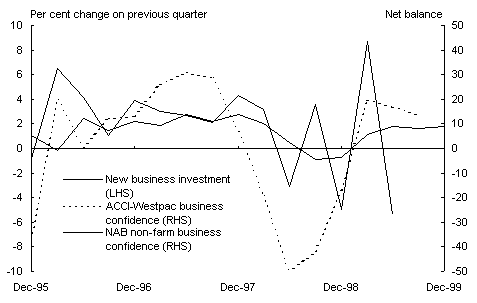
After abstracting from the sale of second-hand assets to the private sector, public final demand grew by 3 per cent in 1998-99, compared with a Budget forecast of 1 per cent and 4 per cent forecast in the MYEFO. This growth was driven by strong underlying investment at both the Commonwealth and State/local levels, together with solid growth in Commonwealth consumption expenditure.
Stocks contributed 0.7 percentage points to GDP growth in 1998-99, significantly higher than the Budget and the MYEFO forecasts. The steep decline in the non farm stocks-to-sales ratio experienced from late 1996 through 1997 was most likely attributable to very strong sales growth over this period, pushing non-farm stocks below desired levels. This decline in the stocks-to-sales ratio was partly reversed during 1998-99 as the ratio increased significantly. However, the sharp increase in the stocks-to-sales ratio in the June quarter 1999 probably reflected some unanticipated stock building due to weaker sales, especially in the manufacturing sector.
4 Consistent with the treatment applied in the 1999-2000 Budget, the underlying cash balance from 1998-99 onwards includes payments of around $1¼ billion per annum by the Commonwealth in respect of accumulated public trading enterprises' superannuation liabilities.
5 In year-average terms, the $A/$US was around US 62.8 cents in 1998-99 (compared with US 68.1 cents in 1997-98); the TWI averaged 56.0 in 1998-99 (compared with 58.3 in 1997-98); and Australian 10-year bond yields averaged 5.4 per cent in 1998-99 (compared with 6.0 per cent in 1997-98).
6 The various industry groupings are: Private services (wholesale trade; retail trade; accommodation, cafes and restaurants; transport and storage; finance and insurance; property and business; cultural and recreational; and personal and other services); Domestic Cyclical (manufacturing and construction); Commodity (External sector) (agriculture, forestry and fishing; and mining); Public Enterprise/Infrastructure (electricity, gas and water; and communication); and General Government (government administration and defence, education; and health and community services).
7 The increase in general government employment growth in 1998-99 as implied from the ABS Labour Force Survey (LFS) contrasts with the fall in public sector employment growth reported by the ABS Wage and Salary Earners Survey (SEE). The difference between the two surveys is likely to reflect the share of private sector employment that is captured in the LFS measure of employment in general government industries.
8 The moderation in implied productivity growth in 1998-99 is consistent with developments in other productivity measures. Growth in trend GDP per hour worked eased from 3.6 per cent in 1997-98 to 2.6 per cent in 1998-99, while growth in trend GDP per hour worked in the market sector fell from 4.3 per cent in 1997-98 to 2.9 per cent in 1998-99. Source: ABS Cat. No. 5206.0.
9 The following industries are assumed to produce non-tradable goods and services: electricity, gas and water supply; construction; wholesale trade; retail trade; accommodation, cafes and restaurants; transport and storage; communication services; finance and insurance; property and business services; government administration and defence; education; health and community services; cultural and recreational services; personal and other services; and ownership of dwellings.
10 Most notably the Commonwealth's sale of the National Transmission Network in 1998-99 and the WA Government's sale of the Dampier to Bunbury pipeline in 1997-98.
11 In part, the stronger public final demand outcome in 1998-99 relative to the Budget forecast reflected classification changes undertaken by the ABS.
